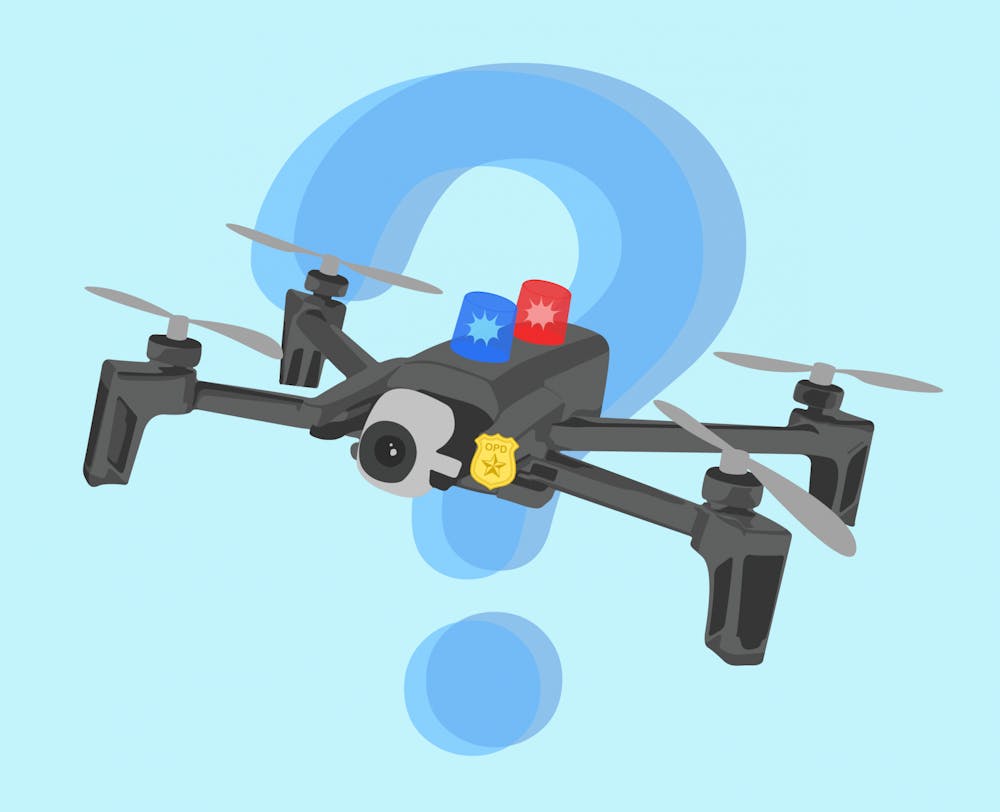In the weeks leading up to Green Beer Day (GBD), students reserved their tables at Uptown bars and decorated with green shamrocks. They also prepared hats, masks and sunglasses to hide their faces from police body cameras and, possibly, drones, as rumors spread throughout the city.
However, despite alleged drone sightings, Assistant City Manager Jessica Greene said the Oxford Police Department (OPD) did not use drones for GBD enforcement on Thursday, March 25.
Rumored use of aerial surveillance led some to wonder whether Oxford even has access to this equipment.
The city does own two main drone units and two small training units which are used for public works, public safety and rescue. Two departments have access to drones: the service and engineering department and OPD.
The service and engineering department received its main drone in 2019 followed by the small trainer in 2020. In addition to public works purposes, Greene said the service and engineering department assisted with public safety before OPD acquired its drones in November 2020.
Funding for the service and engineering department’s main drone came from the engineering division’s 2018 budget, and the smaller trainer was purchased with operating funds. OPD’s drones were included in the city’s annual capital budget, which was reviewed and approved by the city council.
According to Oxford's 2020 budget, the city allocated $489,004 for equipment purchases like police cruisers, playground repairs, computer upgrades, an unmanned aerial system (UAS) – which includes both the drone and equipment to control it – and more. The proposed cost and budget for the UAS alone was $26,700, along with $697 for drone insurance.
Service director Mike Dreisbach wrote in an email to The Miami Student that each small training unit cost $599.
The main units were more expensive: the service and engineering department’s main drone unit cost $7,594 and OPD’s cost $11,349. In addition to the airframes, the mechanical structure of the drones, $10,536 was spent on equipment like camera systems, lighting, extra flight batteries and controllers.
Before approving the purchase, Oxford City Council discussed the expense, how the city would use the drone and how it would be shared with various parts of the city.
Councilor Edna Southard favored the purchase of the drones because of their potential benefits.
“It is a tool,” Southard said. “It’s just one more thing that can be used to help people.”
Enjoy what you're reading?
Signup for our newsletter
The service and engineering and police departments have used drones to search for missing persons, document a crime scene and train derailment, update construction programs and public works projects, assess a fire and more. However, the drones are not used on a regular basis.
Although the drones are operated by these two departments, Greene said the use of drones is up to the discretion of the designated pilot and their supervisor.
“Our pilots will help anyone in the city who needs them,” Greene said. “If it’s needed for a fire, then of course they’ll help the fire department.”
According to 911 security, there is little legislation to cover the use of drones in Ohio. Unlike other states, Ohio has yet to pass specific laws regarding privacy and search warrants, but it did create the aerospace and aviation technology committee in order to promote research and development in the industry.
However, the Federal Aviation Administration (FAA) provides a standard for guidance and operations. Greene said the city’s drones are manned and operated by trained pilots certified by the FAA.
“As an FAA licensed pilot, they have to operate in the national airspace under the guidance and authority of the FAA, and they have to follow all of the rules under that license,” Greene said.
According to an article from The New York Times, the police’s use of new drone technology poses civil liberty concerns.
The use of drone surveillance by police forces angered one Miami student, who spoke under the condition of anonymity.
“I really don’t necessarily agree with the use of drones by police forces just in general because it can easily become a way to increase surveillance and intrude on the privacy of everyday citizens,” he said.
Although Southard acknowledged that there are limits to what each department can do, she said that the technology provides many benefits.
“There is no question that they can be abused [and] that they are expensive, but if they save lives, isn’t that worth it?” Southard said.
As of now, there are no new proposals or funds allocated for future drone purchases.




